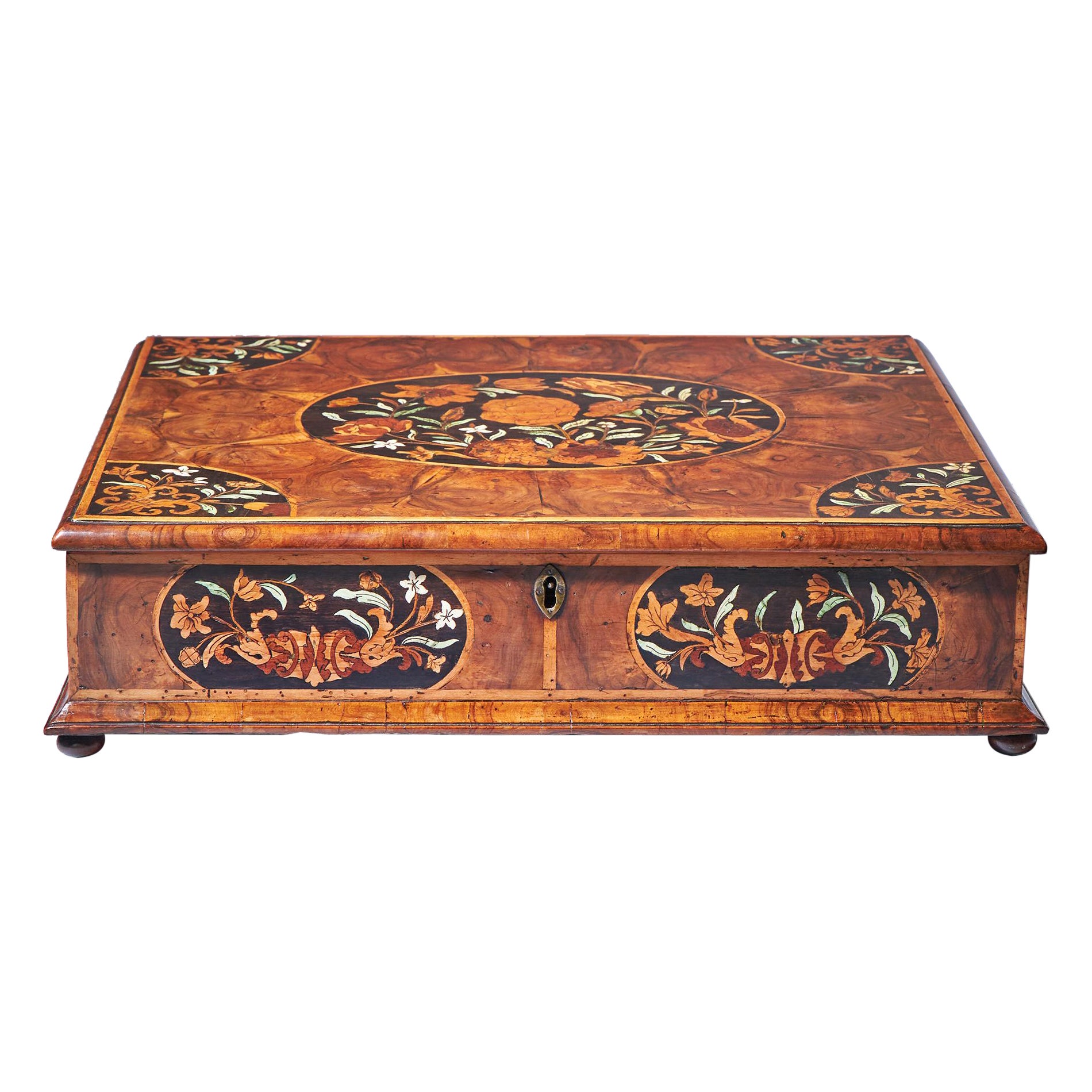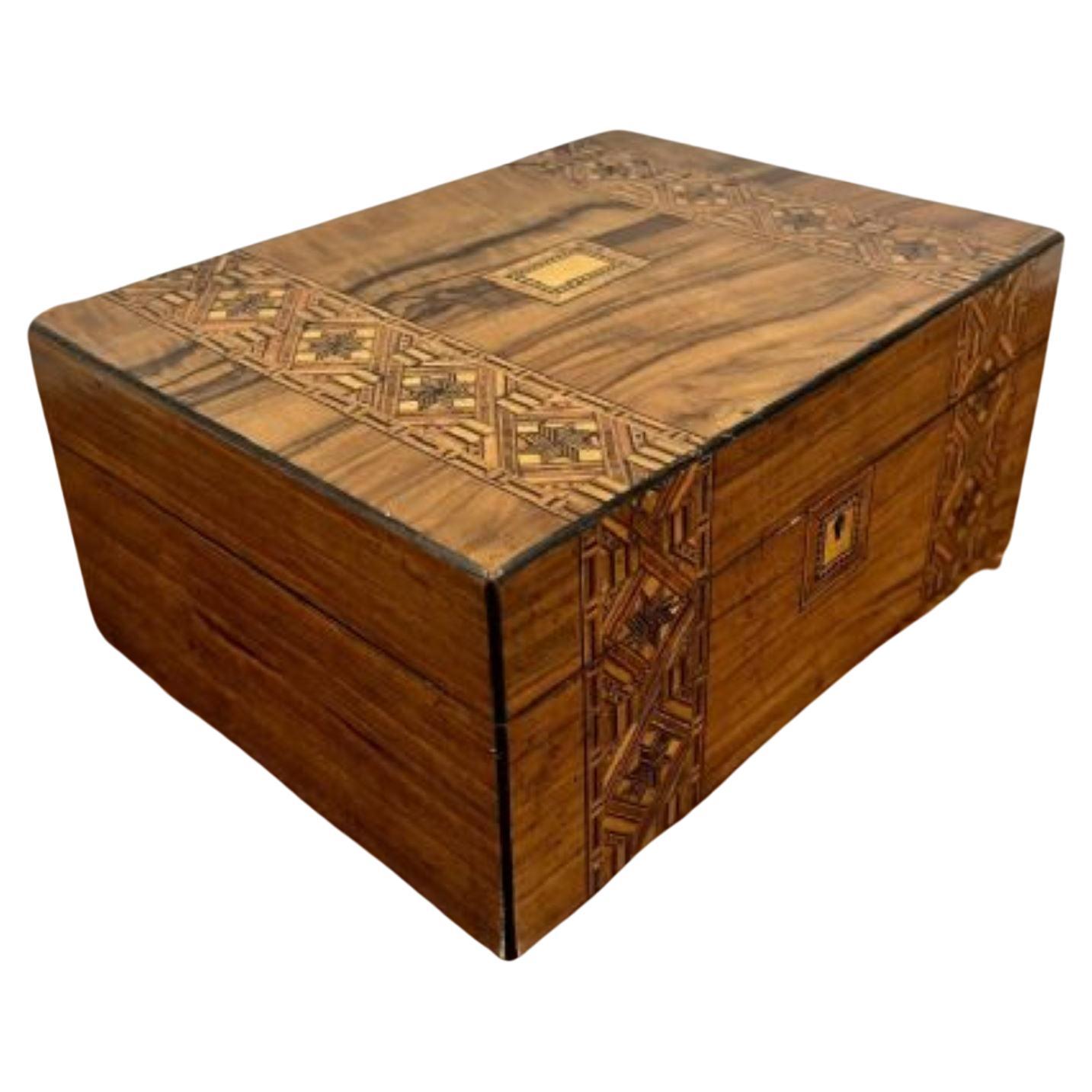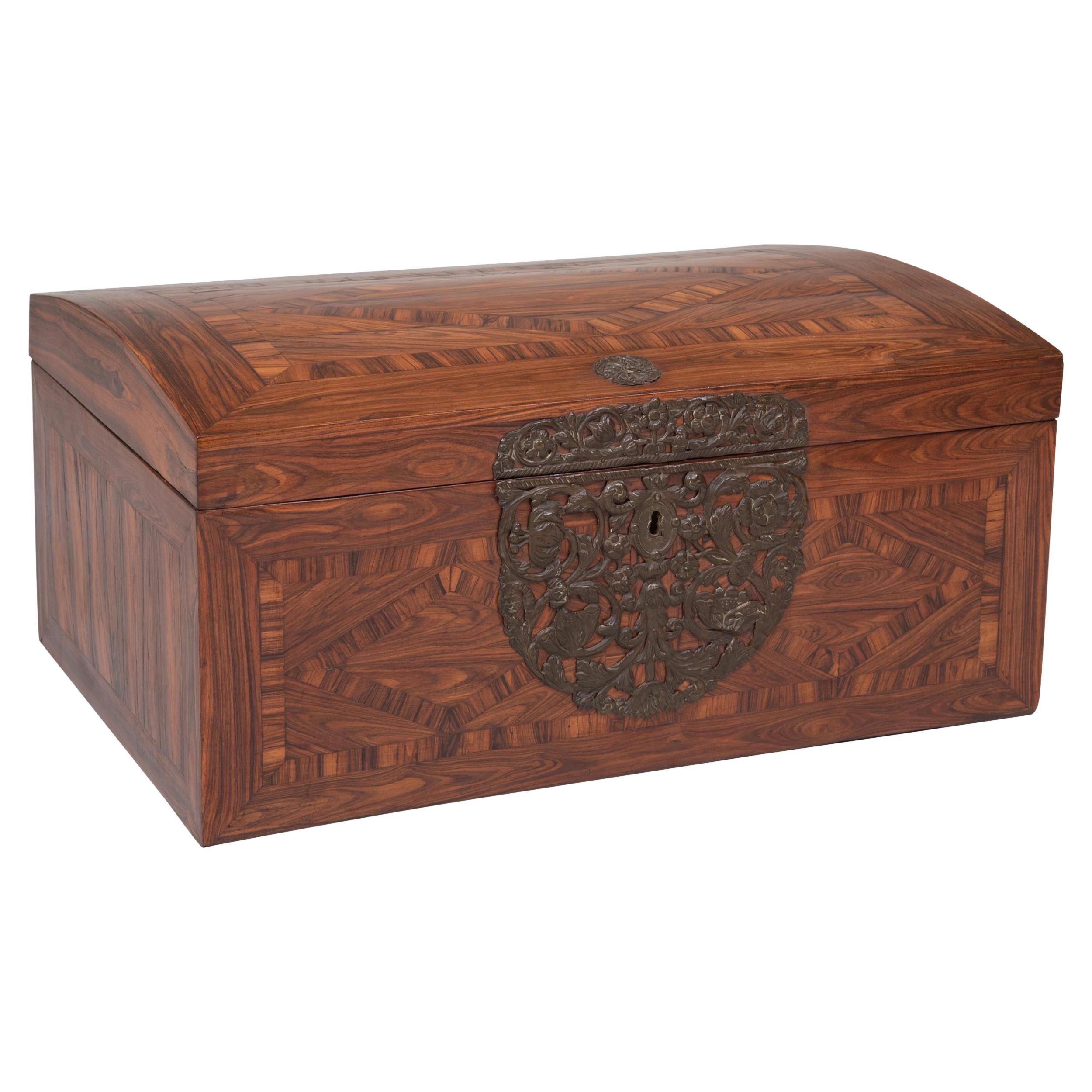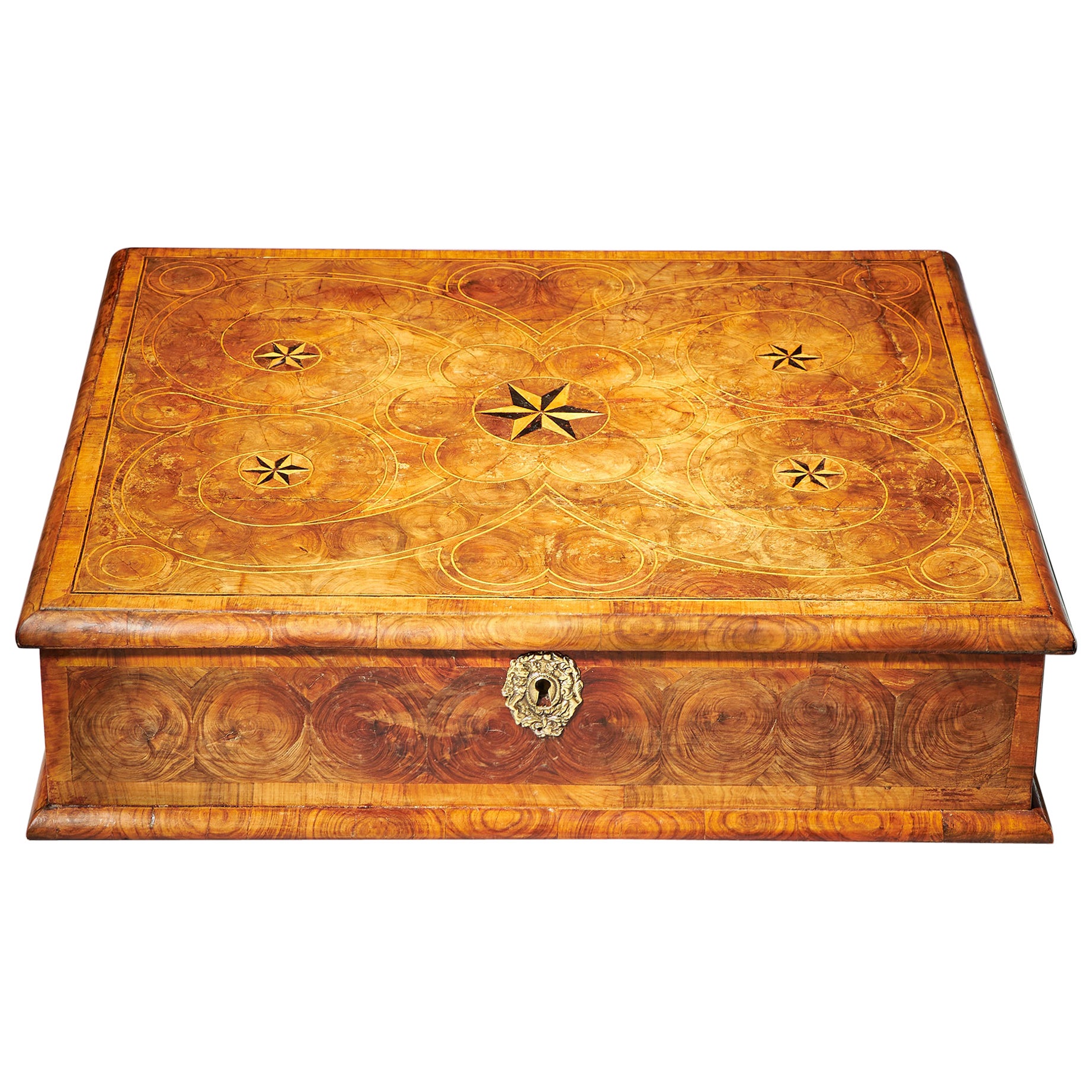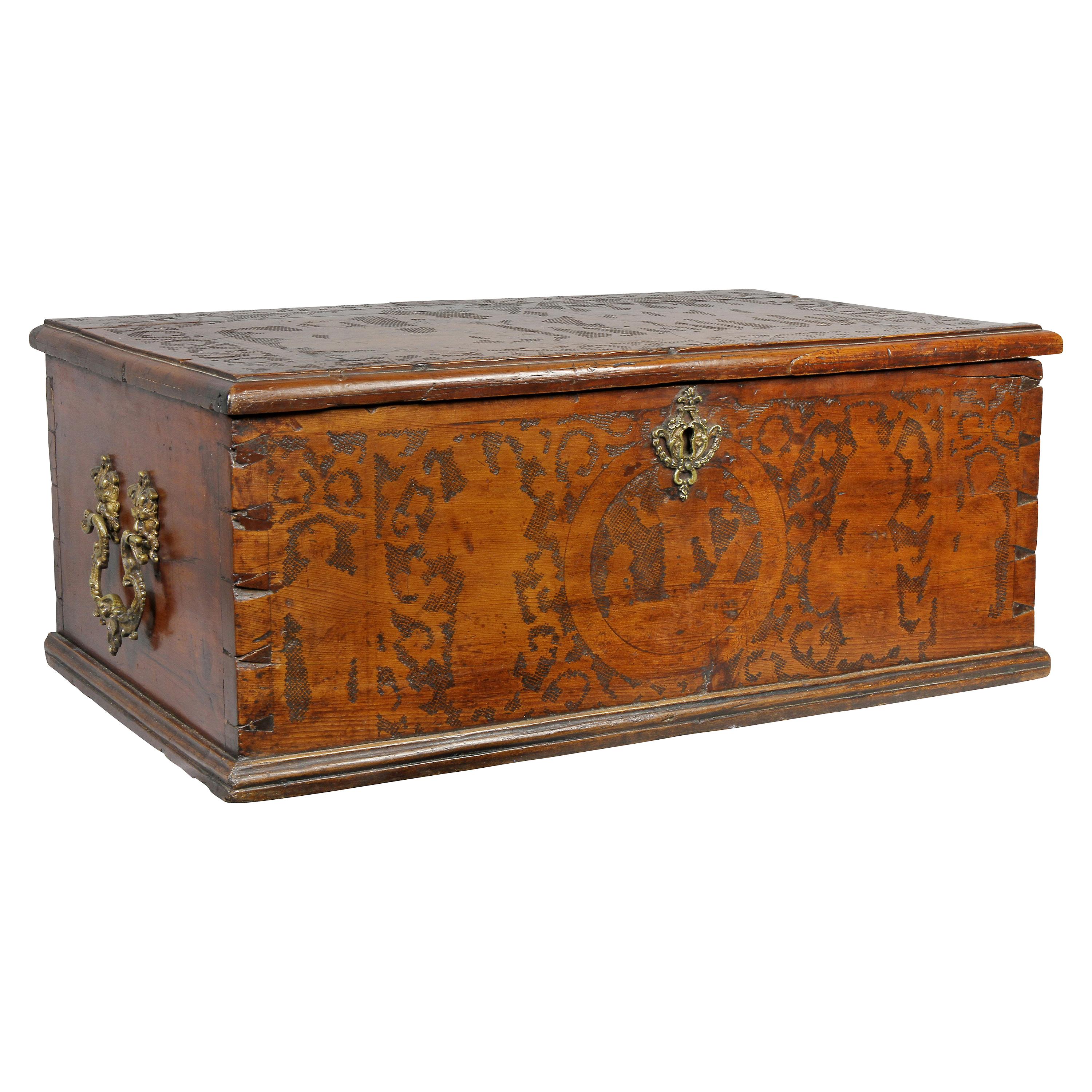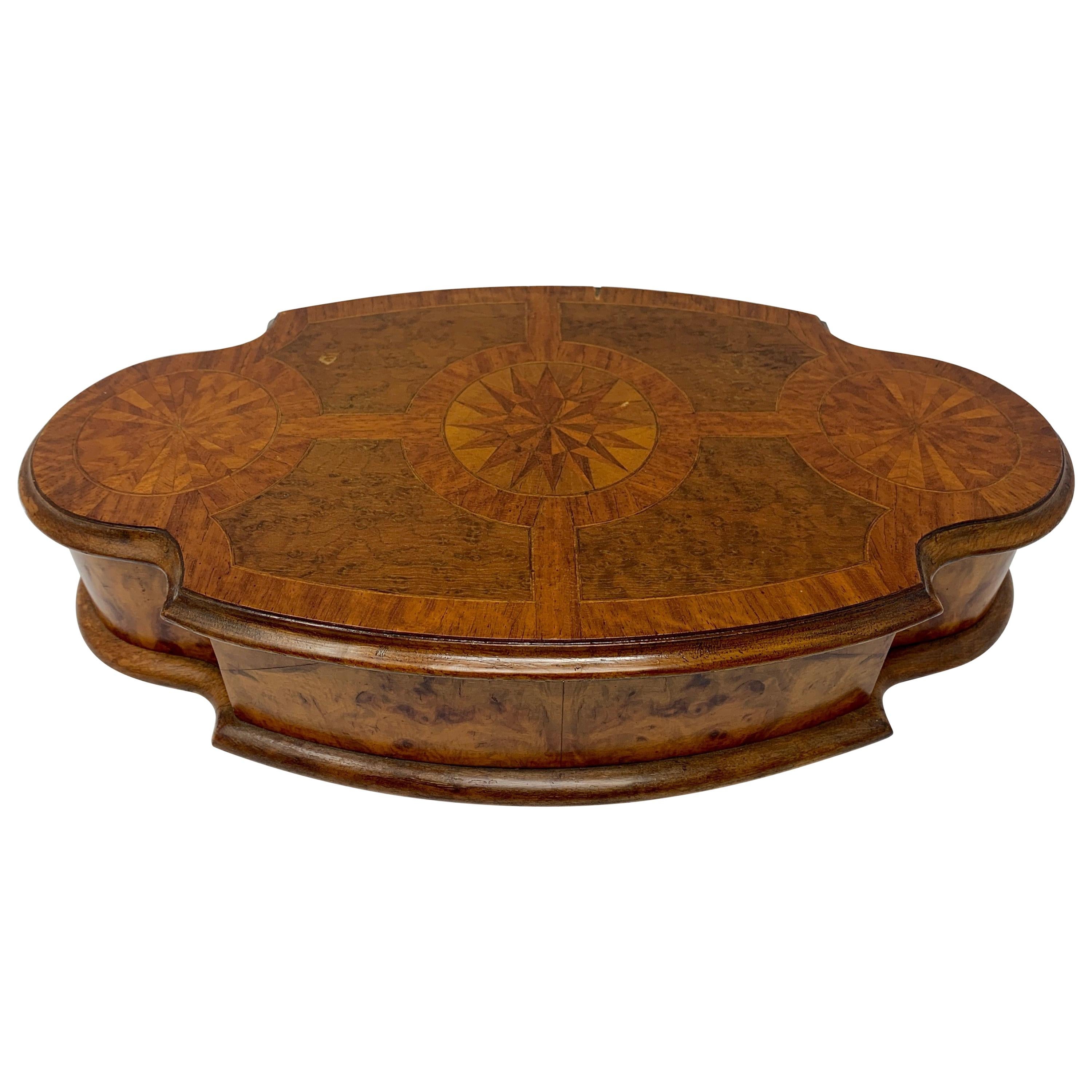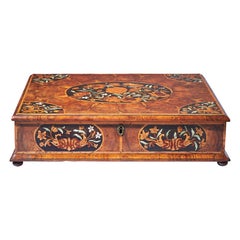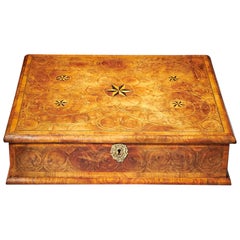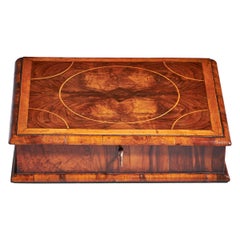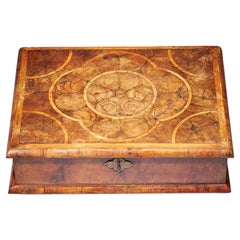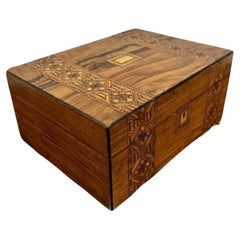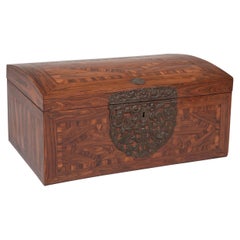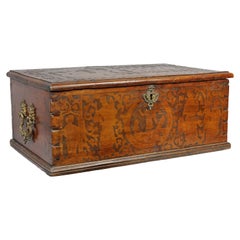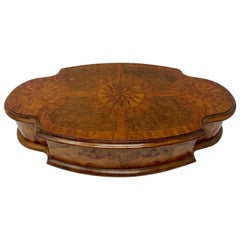Items Similar to 17th Century Figured Walnut and Seaweed Marquetry Lace Box
Want more images or videos?
Request additional images or videos from the seller
1 of 11
17th Century Figured Walnut and Seaweed Marquetry Lace Box
$4,679.35
£3,396.44
€3,966.38
CA$6,478.88
A$7,073.39
CHF 3,708.29
MX$85,909.05
NOK 46,310.49
SEK 43,729.45
DKK 29,604.83
About the Item
A fine and extremely rare figured walnut and seaweed marquetry 'lace box', circa.... let’s break it down - Seaweed marquetry first appeared in English cabinetwork in the late 17th century (Baroque period) though interestingly originated in Italy. Cross-grain mouldings were popular in England from circa 1675-1740, so through the reigns of Charles II, James II, William and Mary, Queen Anne, George I and George II. The long-grain banding around the top and frieze helps to reduce that date down to the last half of the 17th century at least and was used as early as 1660. Taking all into account we can confidently say that this box dates from the last quarter of the 17th century, circa 1675-1690.
The curiously named 'lace box' or 'bible box' veneered in oyster cut hardwoods such as olive, Kingwood, walnut and marquetry were popular amongst the middle and higher classes of society from circa 1660-1700.
- Dimensions:Height: 5.12 in (13 cm)Width: 17.33 in (44 cm)Depth: 13.78 in (35 cm)
- Style:Baroque (Of the Period)
- Materials and Techniques:
- Place of Origin:
- Period:
- Date of Manufacture:1675-1690
- Condition:Wear consistent with age and use.
- Seller Location:Oxfordshire, GB
- Reference Number:1stDibs: LU4936219064262
About the Seller
5.0
Recognized Seller
These prestigious sellers are industry leaders and represent the highest echelon for item quality and design.
1stDibs seller since 2019
24 sales on 1stDibs
Typical response time: A week
Associations
LAPADA - The Association of Arts & Antiques Dealers
- ShippingRetrieving quote...Shipping from: Oxfordshire, United Kingdom
- Return Policy
Authenticity Guarantee
In the unlikely event there’s an issue with an item’s authenticity, contact us within 1 year for a full refund. DetailsMoney-Back Guarantee
If your item is not as described, is damaged in transit, or does not arrive, contact us within 7 days for a full refund. Details24-Hour Cancellation
You have a 24-hour grace period in which to reconsider your purchase, with no questions asked.Vetted Professional Sellers
Our world-class sellers must adhere to strict standards for service and quality, maintaining the integrity of our listings.Price-Match Guarantee
If you find that a seller listed the same item for a lower price elsewhere, we’ll match it.Trusted Global Delivery
Our best-in-class carrier network provides specialized shipping options worldwide, including custom delivery.More From This Seller
View All17th Century William and Mary Floral Marquetry Olive Oyster Lace Box, Circa 1685
Located in Oxfordshire, United Kingdom
A fine and rare 17th-century William and Mary olive oyster floral marquetry lace box, circa 1685. England
The cross grain olive moulded and holly banded top is centred by an oval of...
Category
Antique 17th Century English William and Mary Decorative Boxes
Materials
Bone, Boxwood, Ebony, Oak, Olive, Tulipwood, Holly
Large William and Mary 17th Century Inlaid Olive Oyster Lace Box, Circa 1690
Located in Oxfordshire, United Kingdom
A fine and rare large parquetry inlaid 17th-century William and Mary period olive oyster lace box. 1680-1700, England
The cross-grain moulded top is ent...
Category
Antique 17th Century English William and Mary Decorative Boxes
Materials
Oak, Olive, Ebony
Fine William and Mary 17th Century Olive Oyster Lace Box
Located in Oxfordshire, United Kingdom
A fine late 17th-century olive oyster 'Lace Box' of small proportions, circa 1680-1690, England.
The cross-grain moulded and holly banded top is finely veneered in hand-cut veneers ...
Category
Antique 17th Century English William and Mary Decorative Boxes
Materials
Olive
17th Century William and Mary Olive Oyster Lace Box, Circa 1680-1700
Located in Oxfordshire, United Kingdom
A fine and rare 17th-century William and Mary period olive oyster lace box of perfect proportions. 1680-1700, England
The cross-grain moulded top is entirely covered in well-place...
Category
Antique 17th Century English William and Mary Decorative Boxes
Materials
Olive, Holly
18th Century George III Burr Yew Tea Caddy with Star Inlay and Brass Accents
Located in Oxfordshire, United Kingdom
Exquisite 18th Century Burr Yew Tea Caddy with Star Inlay and Brass Accents, circa 1770. England
This exceptional burr yew tea caddy is a stunning example of Georgian craftsmanship,...
Category
Antique 18th Century English George III Decorative Boxes
Materials
Yew, Burl
18th Century George I Domed Topped Japanned Chinoiserie Falconry Box, circa 1710
Located in Oxfordshire, United Kingdom
A rare and important Queen Anne-George I japanned chinoiserie domed topped box depicting scenes of falconry, circa 1710-1720. England
Falconry is ...
Category
Antique Early 18th Century English Chinoiserie Decorative Boxes
Materials
Oak
You May Also Like
Antique Victorian burr walnut Tunbridgeware inlaid work box
Located in Ipswich, GB
Antique Victorian burr walnut Tunbridgeware inlaid work box, having a quality burr walnut Tunbridgeware inlaid box opening to reveal a fitted interior to the lid and a large compartm...
Category
Antique Early 19th Century Victorian Decorative Boxes
Materials
Walnut
17th Century Franco Flemish Kingwood Marquetry Box
Located in Greenwich, CT
Fine 17th century domed box with highly figured kingwood marquetry veneer laid in a geometric pattern, the front having elaborate pierced and embossed brass escutcheon, the whole wit...
Category
Antique 1690s European Baroque Jewelry Boxes
Materials
Kingwood, Pine
Italian Baroque Walnut Box
Located in Essex, MA
Hinged top, decorated overall with incised carving, lock plate and side handles.
Category
Antique 1670s Italian Baroque Decorative Boxes
Materials
Walnut
Antique English Walnut Box with Exotic Wood Inlay, Intricate Design
Located in New Orleans, LA
The wood inlay on this box is marvelous.
Category
Antique Late 19th Century Decorative Boxes
Materials
Walnut
Baroque Casket, around 1760, birch burl and walnut
Located in Münster, DE
Casket
Baroque, around 1760, birch burl and walnut, round lid with folding star inlay and pewter thread inlays, original lock and fittings, shellac hand polish
Dimensions:
Height: 14 cm
Width: 26 cm
Depth: 20 cm
Most pieces of furniture from the Baroque era date from the period between 1670 and around 1750. Starting with strict but pompous forms, Baroque furniture developed into playful pieces of furniture with numerous curves and magnificent fittings by the middle of the 18th century. Baroque chests of drawers mostly date from the period between 1720 and 1750 and feature multiple curved fronts and veneer marquetry. Baroque tables and chairs feature lavishly curved legs, the lower ends of which end in volutes or animal hooves. Towards the end of the Baroque period and the Rococo period, the curved legs of tables and chairs merge into the frames in a single sweep. Baroque cabinets are usually disproportionately large by today's living standards, as they originally stood in castles. Heights of 2.40 to 2.60 meters are not uncommon for baroque cabinets.
In early Baroque furniture...
Category
Antique 1760s German Baroque Jewelry Boxes
Materials
Nutwood, Birch
19th Century Burr Walnut Jewelry Box
Located in Dublin 8, IE
19th Century burr walnut jewelry box with decorative brass mounts & removable insert tray lined with silk
Category
Antique 19th Century European Jewelry Boxes
Materials
Brass
More Ways To Browse
Italian Cross
English Early 17th Century Furniture
Antique Seaweed
William And Mary English Baroque
Antique Bible Box
Bible Boxes
Seaweed Marquetry
17th Century Lace
French Metal Box
Art Deco Glass Box
Sewing Box
Sewing Boxes
Antique Pine Boxes
Black Lacquered Boxes
Antique Quilling
Antique Rosewood Box
Chinese Vintage Boxes
French Enamel Boxes
